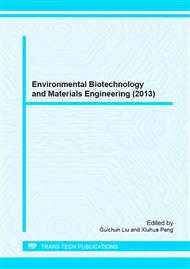p.341
p.347
p.352
p.356
p.360
p.365
p.370
p.375
p.380
Health Risk Assessment of Disinfection By-Products in the Water Distribution Network in a Southern City of Jiangsu
Abstract:
The cancer risk assessment model recommended US EPA was used to access the carcinogenicity of disinfection byproducts (DBPs) in water distribution network in a Southern City of Jiangsu. The trihalomethanes (THMs) and haloacetic acids (HAAs) with carcinogenic risk was considered to be the research focus on the cancer risk assessment. The carcinogenic risk along the pipeline was explored through monitoring the changes of the THMs and HAAs .The results showed as follows: the disinfection by-products increased along the pipe network and cancer risk increased too. The maximum cancer risk within the area of water supply pipe network was calculated. The RTmax was 4.72×10-5, which was between5.10-5 and 10-6. So the carcinogenic risk could be accepted and some measures could be considered to be taken to reduce the carcinogenic risk.
Info:
Periodical:
Pages:
360-364
Citation:
Online since:
September 2013
Authors:
Price:
Сopyright:
© 2013 Trans Tech Publications Ltd. All Rights Reserved
Share:
Citation:


